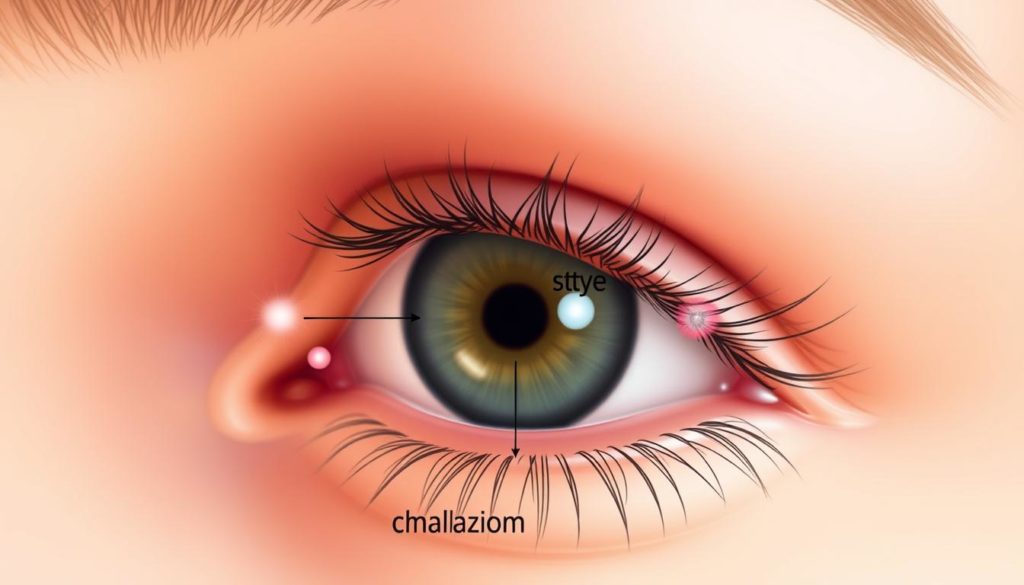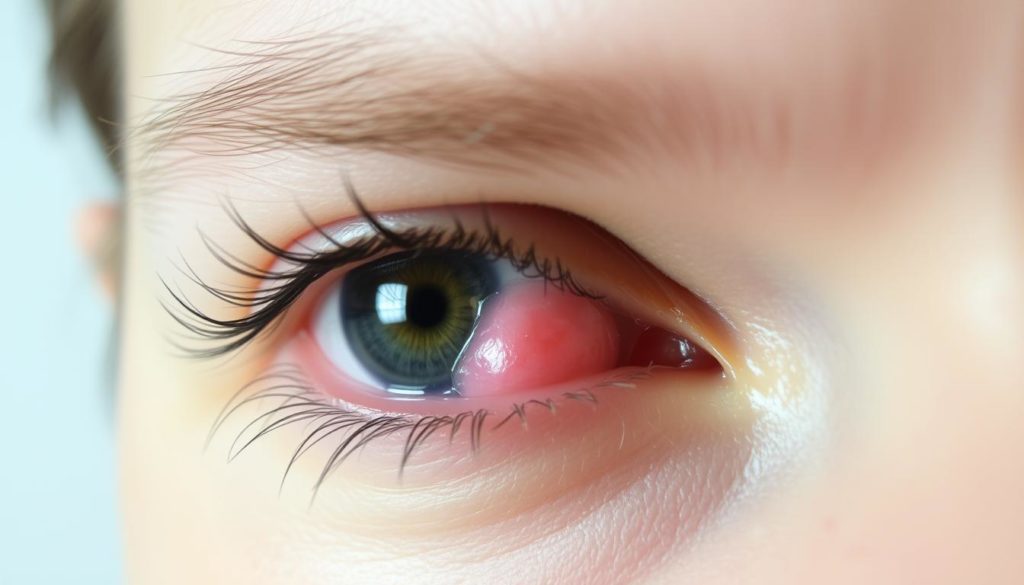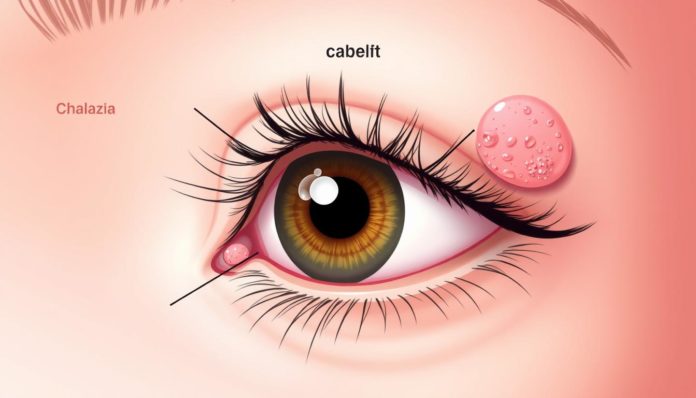Did you know over 80% of people get an eyelid bump at some time? They range from minor annoyances to more severe problems. Knowing what causes eyelid bumps is key for good treatment and prevention.
We’re going to look at what causes these annoying bumps. It could be something simple like a stye or something more complex like ocular rosacea. Understanding the eyelid bump reasons can really help.
Introduction to Eyelid Bumps
Eyelid bumps are common and vary from minor to severe. Understanding their causes is key. This knowledge can improve your eye health and well-being.
The eyelid has delicate tissues and glands. Knowing the eyelid swelling causes helps tell harmless from serious bumps. Some are just styes, but others may be cysts or infections.

There are many eyelid bump types, each with different causes. It’s easy to mix them up. From styes to cysts, knowing these causes of eyelid bumps helps you understand your symptoms and what to do next.
Spotting the type of bump early is important. Causes vary from infections to allergies or health issues. Not paying attention to these can lead to bigger problems, like vision issues.
In conclusion, being informed about eyelid bumps can help fix them quicker. We will now explore specific bump types, their signs, and how to treat them.
Common Symptoms of Eyelid Bumps
Spotting eyelid bump symptoms early is key to getting the right help. Look out for redness, swelling, and pain. These are main signs of an eyelid bump.
Redness
Redness is a clear sign of an eyelid bump. It can come from an infection, an allergy, or irritation. You might see it across the eyelid or just near the bump. If redness sticks around, getting advice from a doctor is a good idea.
Swelling
Swelling is another sign that you might have an eyelid bump. It can be a little puffiness or more noticeable swelling. This means your body is fighting something off. Sometimes, this swelling can affect your vision or make it hard to blink.

Pain
Pain is often the most troubling symptom. It can range from sharp to throbbing, based on the bump’s severity and cause. The bump area may be sensitive, and pain can reach parts of the face nearby. If the pain won’t go away or gets worse, seeing a healthcare professional right away is crucial.
Styes: A Common Cause of Eyelid Bumps
Styes are a major reason why people get bumps on their eyelids. We will look into what styes are, the symptoms they cause, and ways to treat eyelid bumps.
What Are Styes?
A stye, or hordeolum, is when the oil glands in the eyelid get infected. The usual cause is the bacteria known as Staphylococcus aureus. It appears as a red, swollen bump, similar to a pimple. Styes are often found near the eyelid’s edge and can hurt a lot.
Symptoms of Styes
Styes can make simple, everyday tasks feel hard. Here are some signs:
- Redness around the area
- Swollen eyelid
- Pain in the area
- Eyes that water a lot
- A crust forms around the eyelid
How to Treat Styes
Treatment for styes falls into home remedies and medical help.
| Treatment Method | Description |
|---|---|
| Warm Compress | Using a warm compress can reduce pain and help with drainage. Place it on the bump a few times each day for 10-15 minutes. |
| Over-the-Counter Medications | Pain relievers you can buy without a prescription and antibiotic creams can lower swelling and fight infection. |
| Proper Eyelid Hygiene | Keep the eyelid clean and avoid makeup to stop more irritation. |
| Medical Intervention | For tough cases, doctors might suggest antibiotics or even small surgery to remove the stye. |
Knowing about styes and how to recognize them can help pick the best eyelid bump treatment. This way, you can find relief and heal faster.
Chalazion: Understanding This Eyelid Condition
A chalazion is a slow-growing, painless lump on your eyelid. It happens when a meibomian gland gets blocked. While similar to a stye, chalazions are not caused by bacteria and are not painful.
When a gland gets clogged, inflammation leads to a lump. These lumps can get big and might affect your vision. Conditions like rosacea or dermatitis can cause chronic inflammation, leading to these lumps.
Handling a chalazion takes time, often weeks or months. But, you can speed up healing with a few steps:
- Warm compresses soften the cyst for easier draining.
- Clean the area with mild soap and water to avoid more blockages.
- Sometimes, steroids or surgery are needed to remove the chalazion.
Knowing about chalazions and how they differ from styes is key. Let’s compare them:
| Aspect | Chalazion | Stye |
|---|---|---|
| Cause | Blocked Meibomian Gland | Bacterial Infection |
| Symptoms | Painless Lump | Painful Red Bump |
| Infectious | No | Yes |
| Treatment | Warm Compresses, Eyelid Hygiene, Possible Surgery | Antibiotics, Warm Compresses |
| Duration | Weeks to Months | Days to Weeks |
By knowing how chalazions and styes differ, you can manage and treat them better.
Infections Leading to Eyelid Bumps
Eyelid bump causes come from different types of infections. It’s important to know if they are bacterial, viral, or fungal. This helps doctors find the right treatment.
Bacterial Infections
Bacterial infections are common for eyelid bumps. They are often from bacteria named Staphylococcus aureus. This can cause styes and cellulitis. You might see redness, feel swelling, and pain.
Treatment usually needs antibiotics. They can be creams or pills, based on how bad the infection is.
Viral Infections
Viral infections can cause eyelid bumps too. Herpes simplex and Varicella-zoster are examples. They make painful and annoying bumps. These bumps may come with blisters and other issues.
Doctors often give antiviral medicines for these infections.
Fungal Infections
Fungal infections are rarer but still matter. They come from fungi like Candida or Aspergillus. These need antifungal medicines to get better. Signs include itching, redness, and swelling in one spot.
Knowing the infection type is key for the right treatment. If it’s wrong, treatment won’t work well, causing more discomfort. Always check with a healthcare pro to find out the cause of an eyelid bump. They’ll help you get the correct treatment.
Allergic Reactions and Eyelid Bumps
Allergic reactions are a common cause of eyelid bumps. The body reacts to allergens with inflammation around the eyes. Knowing why allergies cause eyelid bumps helps in managing and preventing them.
Some allergens that cause eyelid bumps are:
- Pet dander
- Pollen
- Mold
- Dust mites
- Certain cosmetics
Eye allergies can make your eyes itch, turn red, and swell. This can lead to small, painful lumps on your eyelids. Spotting these signs is important to figure out the reason for eyelid bumps.
To prevent eyelid bumps from allergies, you can:
- Stay away from allergens when you can
- Choose skin care and makeup that won’t cause allergies
- Put cold packs on your eyes to lessen swelling
- Use antihistamine eye drops or pills
Dealing with the causes of eyelid bumps from allergies can really help ease the discomfort they bring.
Contact Dermatitis: Eyelid Bumps from Irritation
Contact dermatitis often leads to eyelid bumps. This happens due to allergic reactions or touching irritants. Knowing what triggers it and its symptoms is key to treat and prevent these bumps.
Common Irritants
There are many irritants that can cause these bumps. Some common ones are:
- Cosmetics like mascara and eyeshadow
- Fragrances in skincare products
- Metals like nickel
- Soaps and detergents
To stop the bumps, it’s important to avoid these irritants.
Symptoms of Contact Dermatitis
The symptoms can be different but often include:
- Redness and swelling
- Itching or a burning feel
- Dry or flaky skin
- Blisters or bumps on the eyelids
Spotting these signs early helps in getting the right treatment quickly. This also aids in preventing more bumps.
Treatment Options
There are a few ways to treat contact dermatitis:
- Avoid the irritants causing the issue
- Apply creams with corticosteroids as your doctor suggests
- Take antihistamines to calm itching and swelling
- Keep your eyelids clean to avoid more irritation
These steps not only ease discomfort but also help prevent bumps in the future.
Here’s a quick overview of the irritants, symptoms, and treatment:
| Category | Details |
|---|---|
| Common Irritants | Cosmetics, fragrances, metals, soaps |
| Symptoms | Redness, swelling, itching, bumps |
| Treatment Options | Avoid irritants, use corticosteroids, antihistamines, good hygiene |
Hormonal Changes and Eyelid Bumps
Hormones regulate many parts of our bodies. When they change, they can cause skin problems. This includes eyelid bumps.
Pregnancy brings big hormone changes. These can change the skin and cause eyelid bumps.
Menstrual cycles cause hormones to go up and down. This can make eyelid bumps appear around that time.
Thyroid issues like hypothyroidism or hyperthyroidism impact eyelid bumps. The thyroid controls many functions, and imbalance affects the skin.
To deal with hormonal eyelid bumps, find the root problem. A doctor can help balance hormones. A good diet and skin care also help.
Here’s how different hormone changes can affect eyelid bumps:
| Hormonal Change | Impact on Eyelid Bumps | Management Tips |
|---|---|---|
| Pregnancy | Increased hormonal activity may cause skin changes, including bumps | Consult with a healthcare provider; use gentle skincare products |
| Menstrual Cycle | Hormonal fluctuations can lead to temporary eyelid bumps | Track cycle; maintain a consistent skincare routine |
| Thyroid Issues | Imbalance in thyroid hormones can result in skin texture changes | Seek thyroid function tests; follow prescribed treatment |
Cysts and Other Growths on the Eyelid
Eyelid bumps can be due to various cysts and other non-dangerous growths. Knowing why eyelid bumps happen and their types is crucial for proper care. Let’s look into epidermoid cysts, sebaceous cysts, and other growths you might see on the eyelids.
Epidermoid Cysts
Epidermoid cysts are a kind of eyelid bump. They grow slowly, are small, and don’t usually hurt. They’re caused by keratin piling up under the skin. What leads to eyelid bumps like epidermoid cysts can differ. But, it’s often blocked hair follicles or damage to the skin.
- Symptoms: A small, round bump on the eyelid. It might be white or yellowish.
- Treatment: They don’t always need treatment. But if they get infected or bothersome, surgery can remove them.
Sebaceous Cysts
Sebaceous cysts are another eyelid bump type. They come from clogged sebaceous glands. These bumps slowly get bigger and have an oily liquid called sebum inside.
- Symptoms: A noticeable bump under the skin. Might be tender or swollen if infected.
- Treatment: These can be drained by a doctor. Sometimes, minor surgery is needed to take out the cyst wall to stop them from coming back.
Other Growths
There are also other growths that might show up on eyelids. For example, xanthelasma are yellowish spots often tied to cholesterol problems. The causes of eyelid bumps like these vary, from lipid issues to factors related to getting older.
- Symptoms: Soft, yellow spots on the eyelids, usually close to the nose.
- Treatment: Getting rid of them might need chemical peels, laser treatment, or taking them out through surgery, based on the growth’s size and cause.
Ocular Rosacea and Eyelid Bumps
Ocular rosacea is a kind of rosacea that affects the eyes. It causes painful and unsightly bumps on the eyelids. These bumps might be confused with other conditions. It’s key to know what makes ocular rosacea different.
Understanding Ocular Rosacea
Ocular rosacea makes the area around the eyes inflamed. It may go along with facial rosacea or happen on its own. We’re not sure what causes it yet. But, genes and the environment might influence it.
Symptoms of Ocular Rosacea
Symptoms of ocular rosacea include bumps on the eyelids. People also report redness, dryness, and eye irritation. Other signs could be:
- Watery or bloodshot eyes
- Stinging or burning sensation
- Blurred vision
- Swollen eyelids
Treatment Options
To treat ocular rosacea, focusing on symptom management is crucial. Doing so helps enhance comfort and prevent worse problems. There are several ways to aid this:
- Medications: Use of prescription eye drops, oral antibiotics, and creams to lessen inflammation.
- Lifestyle Modifications: Adapting skincare habits, steering clear of triggers, and keeping the eyelids clean.
- Warm Compresses: Putting warm compresses on the eyes can ease pain and open up any blockages.
- Consulting an Ophthalmologist: Regular visits to an eye doctor are important for tracking and handling the condition.
Eyelid Bump Causes: Uncover the Reasons Behind
Eyelid bumps come from different sources. It’s key to understand the main and other factors that lead to them. Looking at earlier information helps us know why these bumps appear. We’ll also see how genes might make some people more likely to get them.
Primary Causes
Styes and chalazions are common causes of eyelid bumps. They happen when oil glands get blocked. Bacterial, viral, and fungal infections can also cause eyelid swelling. Additionally, allergic reactions and contact dermatitis are directly linked to these bumps. Catching these primary reasons early can prevent worse symptoms.
Secondary Factors
Hormonal changes during adolescence, pregnancy, or menopause play a role too. Stress, not keeping clean, and irritants in the environment also make it worse. Knowing these factors helps in preventing and managing eyelid bumps effectively.
Genetic Predispositions
Genetic factors are also important in eyelid swelling causes. If your family has skin conditions like ocular rosacea, you might be more likely to get eyelid bumps. Understanding these genetic links helps with early care and better treatment plans.
FAQ
What are some common reasons for eyelid bumps?
Eyelid bumps come from various causes like styes, chalazions, infections, and allergies. Hormonal changes also play a role. It’s crucial to pinpoint the cause for the right treatment.
What symptoms should I look for if I suspect an eyelid bump?
Look out for redness, swelling, pain, and sometimes itching. These are common signs of eyelid bumps. Seeing these symptoms means it’s time to see a doctor.
How do styes form, and what can I do to treat them?
Styes come from bacterial infections in the eyelid’s oil glands. You can treat them with warm compresses and cleanliness. For worse cases, you may need a doctor’s help.
What’s the difference between a stye and a chalazion?
Styes and chalazions are both eyelid bumps but different. A stye is a painful oil gland infection. A chalazion, painless, is a blocked oil gland causing swelling.
Can infections cause eyelid bumps, and how are they treated?
Yes, infections from bacteria, viruses, and fungi can cause eyelid bumps. The treatment can be antibiotics, antivirals, or antifungals, based on the infection type.
How do allergic reactions cause eyelid bumps?
Allergic reactions from pollen, dust, or makeup can create eyelid bumps. Avoid the allergen and use antihistamines or anti-inflammatory meds for management.
What is contact dermatitis, and how does it relate to eyelid bumps?
Contact dermatitis is skin irritation from direct contact with certain substances. It causes redness, itching, and bumps. Treatment includes avoiding the irritants and soothing the skin.
Could hormonal changes lead to eyelid bumps?
Hormonal changes, like during pregnancy or thyroid issues, can cause eyelid bumps. Addressing the hormonal imbalance helps manage these bumps.
What kinds of cysts can form on the eyelid?
Epidermoid and sebaceous cysts are common on eyelids. They’re mostly harmless but might need treatment if uncomfortable. Treatments include draining or removing them.
How does ocular rosacea cause eyelid bumps?
Ocular rosacea can cause eyelid bumps, along with redness and irritation. Treating it involves managing rosacea and using eye-specific medications.
Are there any genetic factors that make eyelid bumps more likely?
Yes, genetics can influence the likelihood of developing eyelid bumps. Some skin types are more prone to conditions like acne or rosacea, affecting the eyelids.


